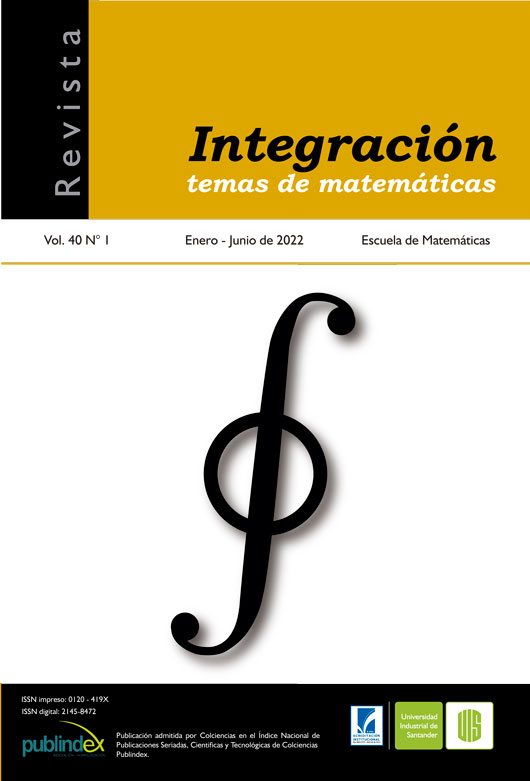Artículos científicos
Estabilidad polinomial de un sistema termoelástico con disipación lineal en la frontera y segundo sonido
Publicado 2022-03-01
Palabras clave
- Sistema termoelástico,
- Ley de Cattaneo,
- Ley de Fourier,
- Estabilidad polinomial,
- Método de Lyapunov
Cómo citar
Cortés, R. M. (2022). Estabilidad polinomial de un sistema termoelástico con disipación lineal en la frontera y segundo sonido. Revista Integración, Temas De matemáticas, 40(1), 59–75. https://doi.org/10.18273/revint.v40n1-2022003
Derechos de autor 2022 Revista Integración, temas de matemáticas

Esta obra está bajo una licencia internacional Creative Commons Atribución 4.0.
Resumen
En este artículo se considera un sistema termoelástico definido en Ω ×R+, Ω ⊂ Rn, n ≥ 2, con ley de difusión de calor dada por la ley de Cattaneo. Introduciendo un mecanismo disipativo lineal en una parte de la frontera se obtiene la buena postura y el decaimiento polinomial de la energía de las soluciones del sistema.
Descargas
Los datos de descargas todavía no están disponibles.
Referencias
- Borichev A. and Tomilov Y., “Optimal polynomial decay of functions and operator semigroups”, Math. Ann., 347 (2010), No. 2, 455-478. doi: 10.1007/s00208-009-0439-0
- Cattaneo C., “Sulla conduzione del calore”, Atti Sem. Mat. Fis. Univ. Modena, 3 (1948), 83-101.
- Chandrasekharaiah D.S., “Thermoelasticity with second sound: a review”, Appl. Mech. Rev. March., 39 (1986), No. 3, 355-376. doi: 10.1115/1.3143705
- Dafermos C.M, “On the existence and the asymptotic stability of solutions to the equations of linear thermoelasticity”, Arch. Ration. Mech. Anal., 29 (1968), No. 4, 241-271. doi: 10.1007/BF00276727
- Ismscher T. and Racke, R., “Sharp decay rates in parabolic and hyperbolic thermoelasticity”, IMA J. Appl. Math., 71 (2006), No. 3, 459-478. doi: 10.1093/imamat/hxh110
- Kovalenko A.D., Thermoelasticity: basic theory and applications., Wolters-Noordhoff, Groningen, 1969.
- Lagnese J.E., “Decay of solutions of wave equations in a bounded region with boundary dissipation”, J. Differential Equations, 50 (1983), No. 2, 163-182. doi: 10.1016/00220396(83)90073-6
- Lagnese J.E., “Note on boundary stabilization of wave equations”, SIAM J. Control Optim., 26 (1988), No. 5, 1250-1256. doi: 10.1137/0326068
- Lebeau G. and Zuazua E., “Sur la décroissance non uniforme de l’énergie dans le système de la thermoélasticité linéaire”, C. R. Math. Acad. Sci. Soc. R. Can., 324 (1997), No. 4, 409-415. doi: 10.1016/S0764-4442(97)80077-8
- Liu W. and Zuazua E., “Uniform stabilization of the higher-dimensional system of thermoelasticity with a nonlinear boundary feedback”, Quart. Appl. Math., 59 (2001), No. 2, 269-314. doi: 10.1090/qam/1828455
- Liu W., “Partial exact controllability and exponential stability in higher-dimensional linear thermoelasticity”, ESAIM Control Optim. Calc. Var., 3 (1998), 23-48. doi: 10.1051/cocv:1998101
- Liu Z. and Zheng S., Semigroups associated with dissipative systems, CRC Press, vol. 398, Oxford, 1999.
- Narukawa K., “Boundary value control of thermoelastic systems”, Hiroshima Math. J., 13 (1983), No. 2, 227-272. doi: 10.32917/hmj/1206133391
- Pazy A., Semigroups of linear operators and applications to partial differential equations, Springer Science & Business Media, New York, vol. 44, 2012.
- Racke R. and Ya-Guang W., “Asymptotic behavior of discontinuous solutions in 3-d thermoelasticity with second sound”, Quart. Appl. Math., 66 (2008), No. 4, 707-724. doi: 10.1090/S0033-569X-08-01121-2
- Racke R., “Thermoelasticity with second sound-exponential stability in linear and non-linear 1-d”, Math. Methods Appl. Sci., 25 (2002), No. 5, 409-441. doi: 10.1002/mma.298
- Sidoroff F., “Mécanique des milieux continus”, École D’ingénieur (1980), 166.
- Tarabek M.A., “On the existence of smooth solutions in one-dimensional nonlinear thermoelasticity with second sound”, Quarterly of Applied Mathematics, 50 (1992), No. 4, 727-742. doi: 10.1090/qam/1193663
- Zuazua E., “Uniform Stabilization of the wave equation by nonlinear Boundary Feedback”, SIAM J. Control Optim., 28 (1990), No. 2, 466-477. doi: 10.1137/0328025
